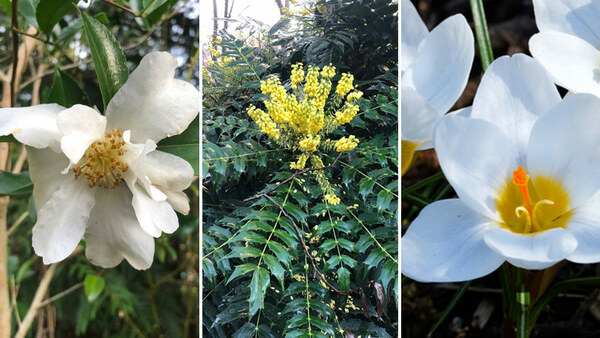
While working in your garden, do you work on cultivating every square inch of ground? Do you mow, string trim, prune, and weed throughout? Have you ever thought of leaving a bit of untidiness, undisturbed ground, and weeds? This may go against your inner-gardener instincts or what you were taught at one time, but leaving a piece of ground unkept for a more wild garden is an easy, beneficial, and very important thing to do.
A diverse mix of plants, animals, fungi, and microorganisms is critical
In the area where I live on Bainbridge Island in Washington, near the forest edge at the top of my property is a loose, wild “planting” with lots of herbaceous and evergreen native plants. Biodiversity happily exists here. Many people don’t understand the need for biodiversity—land that has a rich mix of plants, animals, fungi, and microorganisms. All the flora and fauna living and working together provide habitat that sustains life, including people. Loss of these areas is in a critical state across the world. Loss of diverse ecological landscapes like this one and the extinction of plants and animals is a real problem, for ALL of us.
No matter the size, letting your garden go a bit wild keeps nature’s systems moving along smoothly
Now I realize that this little bit of land on my property may not make the difference that a national park or large conservation site would, but think of the collective effect if everybody did a little bit to promote biodiversity in the area in which they live. The small wild garden area on my property is teaming with layers of biodiversity that begin with a deep stratum of fallen leaves, which is used by some animals to create cozy winter dens. These animals, such as field mice, moles, and voles, play a part in every garden, aerating the soil and adding organic matter.
As the leaves break down, it becomes leaf litter (nature’s mulch) with the help of other small creatures or organisms. Lifting the leaf litter mulch, you can see the white threads of beneficial fungi breaking down and creating good soil. These saprophytic fungi feed on dead organic matter, like mulch, compost, and various soil conditioners (like animal manure). They are critical to soil health. They are one of the primary organisms that break down raw organic matter into humus and release essential minerals to plant roots. This naturally occurring fertilizer benefits all the plants in this area, including the trees.

Weeds play a key role in biodiversity too
Another important layer in the ecological landscape is the “weeds.” While typically unwelcome in any of our cultivated beds, plants like stinging nettle (Urtica dioica), Queen Anne’s lace (Daucus carota), vanilla leaf (Achlys triphylla), candy flower (Claytonia sibirica), and bishop’s cap (Mitella trifida) play a key role as food for insects and other animals in the biodiversity network. Stinging nettle, for example, is a host plant for a number of butterfly and moth species. It also provides great perennial habitat for a wide range of other beneficial pollinators and predatory insects, from native bees to parasitic wasps.

I’ve added sword fern (Polystichum munitum, Zones 5–9) and wintergreen (Gaultheria procumbens, Zones 3–8) to the wild woodland area. Western bleeding heart (Dicentra formosa, Zones 4–8) reseeds and spreads throughout the sunnier areas. The stream that flows nearby has salmonberry (Rubus spectabilis, Zones 5–8) and skunk cabbage (Lysichiton americanus, 4–8) growing in the moist soil there. Together, all these plants, along with the wildlife and other creatures that live here, create a beneficial ecosystem and interdependent web of biodiversity.
Am I tempted to clean this out, add more cultivated plants, irrigate, and create a serene garden space in the forest? Yes, but the sustainability benefits of the “weed” patch are greater than the need for another garden area.
—Susan Calhoun is the owner of Plantswoman Design in Bainbridge Island, Washington.
Photos: Susan Calhoun


















Comments
Log in or create an account to post a comment.
Sign up Log in